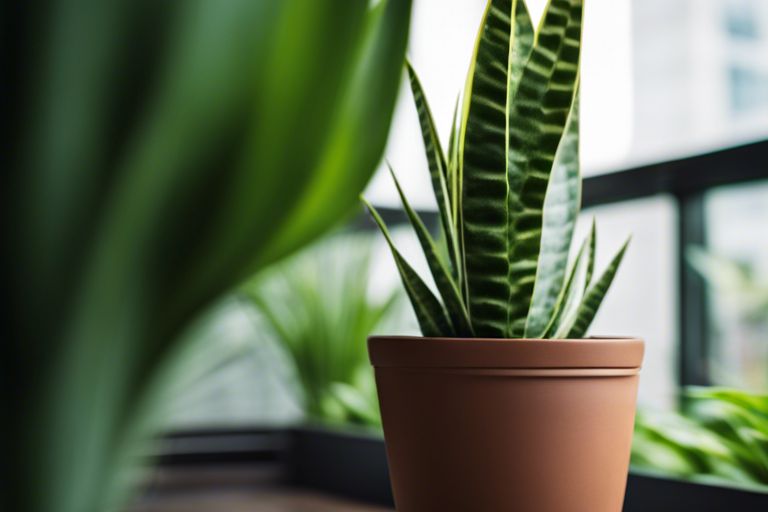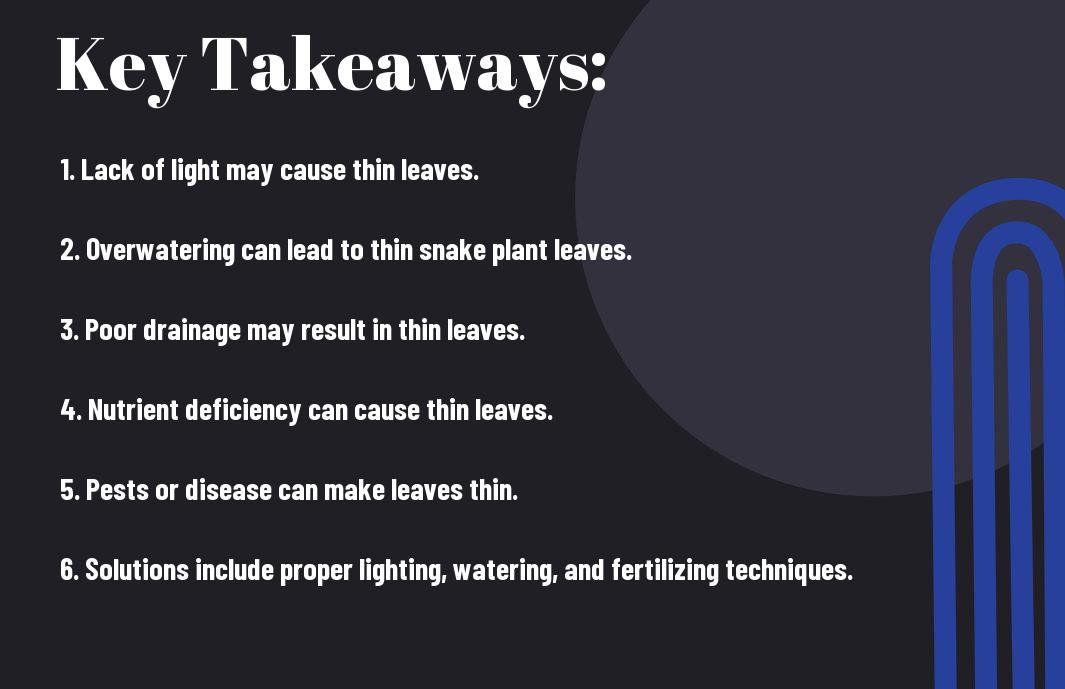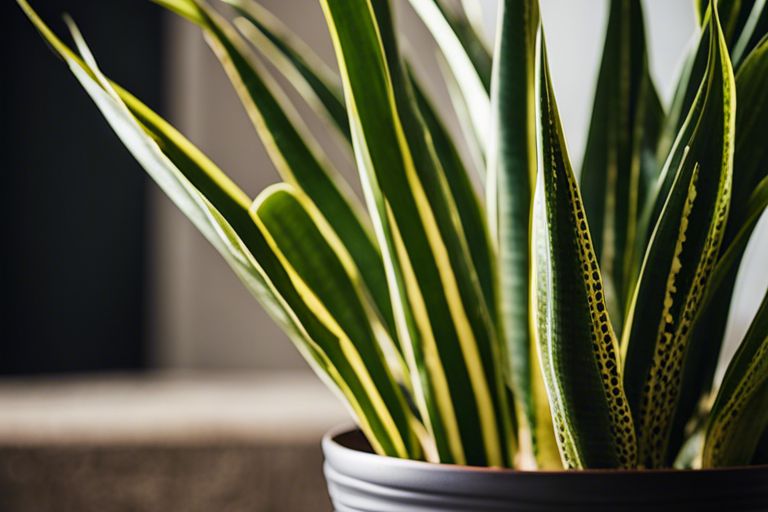There’s a common concern among snake plant owners when they notice their plant’s leaves becoming thin and unhealthy. Thin leaves can be a sign of various issues that need to be addressed promptly to prevent further damage to the plant. In this blog post, we will probe into the possible causes of why snake plant leaves may be thinning and explore solutions to help restore their health and vitality.

Key Takeaways:
- Improper Watering: Overwatering or underwatering can cause thinning of snake plant leaves. It is important to maintain a balanced watering schedule to keep the leaves healthy and sturdy.
- Lack of Nutrients: Snake plants require proper nutrients to thrive. A deficiency in important nutrients like nitrogen, magnesium, or iron can lead to thin leaves. Consider using a balanced fertilizer to provide the plant with necessary nutrients.
- Poor Lighting Conditions: Inadequate or excessive light exposure can also result in thin snake plant leaves. Ensure that the plant receives the appropriate amount of indirect sunlight to promote healthy leaf growth.

Understanding the Anatomy of Snake Plant Leaves
Structure of Snake Plant Leaves
For those delving into the mystery of why snake plant leaves may appear thin, it’s vital to grasp the basic anatomical structure of these resilient plants. Snake plant leaves are composed of several layers. The outer layer, known as the epidermis, provides protection and regulates water loss. Beneath the epidermis lies the mesophyll layer, where photosynthesis primarily occurs. The mesophyll is further divided into palisade and spongy layers, each playing a crucial role in the plant’s metabolic processes.
Factors Influencing Leaf Thickness
If you’re puzzled by the thinness of your snake plant’s leaves, understanding the factors that influence leaf thickness is crucial. Light intensity is a key factor impacting leaf thickness. Plants grown in low light conditions may develop thinner leaves to maximize light absorption. Water availability also plays a significant role. Insufficient watering can lead to thinner leaves as the plant conserves resources. Furthermore, nutrient deficiency can result in stunted growth and thin leaves, as vital nutrients are necessary for healthy leaf development.
- Light intensity: Low light can lead to thin leaves to enhance light absorption.
- Water availability: Inadequate watering can cause thin leaves as the plant conserves resources.
- Nutrient deficiency: Lack of necessary nutrients can result in thin, stunted leaves.
Any deviations in these factors can impact the thickness of snake plant leaves, requiring attention to ensure optimal growth and foliage development.
Another crucial factor influencing leaf thickness is humidity levels. Snake plants thrive in moderate humidity levels, and inadequate humidity can lead to thinner leaves. It’s imperative to provide adequate moisture in the air to support healthy leaf structure. Additionally, pot size can also influence leaf thickness. If the snake plant is root-bound due to a small pot, it may exhibit thinner leaves as a result of restricted growth. Ensuring the plant has ample space for root expansion can contribute to thicker, healthier foliage.
Environmental Factors Affecting Leaf Thickness
Despite the snake plant’s reputation for being tough and resilient, its leaves can sometimes appear thin and weak. Several environmental factors can contribute to this issue, affecting the plant’s overall health and appearance. Understanding these factors is crucial in addressing the problem and restoring the plant’s vitality.
Light Exposure and Leaf Thinness
Thinness in snake plant leaves can often be linked to inadequate light exposure. Snake plants are known for their ability to thrive in low-light conditions, but prolonged exposure to darkness can lead to thinner leaves. When a snake plant doesn’t receive enough light, it struggles to photosynthesize properly, resulting in weak leaf growth. To remedy this issue, place the plant in a location where it can receive moderate to bright, indirect light. Avoid exposing it to direct sunlight, as this can cause sunburn and further damage the leaves.
Temperature Extremes and Plant Stress
For snake plants, temperature extremes can play a significant role in leaf thinness. These plants prefer temperatures between 60°F and 80°F (15°C to 27°C) and can suffer in excessively hot or cold environments. Extreme cold can cause damage to the plant’s cells and inhibit proper nutrient absorption, leading to thin and weak leaves. On the other hand, high temperatures can stress the plant and result in reduced leaf thickness. Maintaining a consistent temperature range and avoiding sudden fluctuations can help promote healthy leaf growth in snake plants.
| Temperature Extremes | Effects on Snake Plants |
| High Temperatures | Stress the plant and reduce leaf thickness |
| Low Temperatures | Damage cells and inhibit nutrient absorption |

Watering Habits and Their Impact on Leaf Thickness
Now, let’s probe into the crucial role that watering habits play in determining the thickness of snake plant leaves. The amount and frequency of water you provide to your snake plant can have a significant impact on its overall health and leaf thickness. Understanding the implications of overwatering and underwatering is crucial for maintaining a thriving snake plant.
Overwatering and Root Rot
For snake plants, overwatering is one of the most common culprits behind thinning leaves. When you water your snake plant too frequently or excessively, the soil becomes waterlogged, leading to root rot. Root rot can prevent the roots from absorbing crucial nutrients and moisture, resulting in thin, wilted leaves. To prevent overwatering, ensure that your snake plant’s pot has proper drainage and allow the soil to dry out between waterings.
Underwatering and Drought Stress
Underwatering is another factor that can cause snake plant leaves to become thin. When a snake plant does not receive enough water, it enters a state of drought stress. Drought stress can cause the plant to conserve water by reducing leaf thickness and growth. To avoid underwatering, establish a consistent watering schedule and adjust it based on the plant’s specific needs and environmental conditions.
Their adaptation to dry conditions makes snake plants resilient to occasional underwatering, but prolonged drought stress can lead to noticeable changes in leaf thickness and overall plant health. It is crucial to strike a balance in your watering routine to ensure that your snake plant thrives and maintains its characteristic sturdy leaves.
Soil Composition and Nutrient Availability
Importance of Well-draining Soil
One crucial factor that affects the health and growth of snake plants is the soil in which they are planted. Well-draining soil is important for snake plants as it helps prevent waterlogging, which can lead to root rot and other issues. When the roots are sitting in soggy soil for prolonged periods, they struggle to absorb oxygen, causing stress to the plant. This stress can manifest in thin, weak leaves and overall poor plant health.
Essential Nutrients for Robust Leaf Growth
One of the key elements for promoting robust leaf growth in snake plants is ensuring they have access to important nutrients. Plants require a variety of nutrients to thrive, including nitrogen, phosphorus, and potassium. These nutrients play vital roles in various plant functions, from photosynthesis to overall growth and development.
A well-balanced fertilizer specifically formulated for indoor plants can provide snake plants with the necessary nutrients for healthy leaf growth. Overfertilizing can be just as harmful as underfertilizing, so it’s crucial to follow the instructions on the fertilizer packaging and only feed your snake plant as needed.
Common Pests and Diseases that Cause Thin Leaves
Once again, thin leaves on a Snake Plant can be an indication of various pests and diseases that may be affecting the plant. It is crucial to identify and address these issues promptly to prevent further damage to your beloved houseplant.
Identifying Harmful Pests
Diseases can be caused by a variety of pests, including mealybugs, spider mites, and scales. These pests feed on the sap of the plant, leading to weakened leaves that become thin and pale in color. Identifying the presence of these pests early on is vital in protecting your Snake Plant from further damage.
Disease Symptoms and Their Effects on Leaves
The thinning of Snake Plant leaves can also be a symptom of diseases such as root rot or fungal infections. These diseases can cause the roots to decay, leading to a lack of vital nutrients being absorbed by the plant. As a result, the leaves may start to wilt, become thin, and eventually die off.
The effects of diseases on Snake Plant leaves can be devastating if left untreated. Root rot, in particular, can spread quickly throughout the plant and result in irreversible damage. It is crucial to take immediate action at the first sign of disease to salvage the health of your Snake Plant.
Care Practices to Promote Healthy Leaf Growth
Proper Watering Techniques
For optimal growth of your snake plant, it is crucial to implement proper watering techniques. Overwatering can lead to root rot and cause the leaves to become thin and droopy. On the other hand, underwatering can result in dehydration and thinning of the leaves as well. To strike the right balance, water your snake plant only when the top inch of the soil is dry. Use a well-draining potting mix to prevent waterlogging, and ensure that the excess water can easily flow out of the drainage holes.
Adequate Light and Temperature Conditions
For healthy leaf growth, snake plants require adequate light and consistent temperature conditions. Place your plant in a well-lit area, but avoid direct sunlight as it can scorch the leaves. A moderate to bright indirect light exposure is ideal for optimal growth. In the matter of temperature, snake plants thrive in temperatures between 60 to 85°F (15 to 29°C). Avoid exposing your plant to sudden temperature fluctuations or drafts, as these can stress the plant and lead to thinning of the leaves.
Another way to ensure your snake plant’s healthy leaf growth is to maintain a regular feeding and soil health schedule. By providing balanced and diluted fertilizer during the growing season, you can promote lush and vibrant foliage. Additionally, repotting your snake plant every 2-3 years with fresh potting mix can help improve soil aeration and drainage, preventing issues like compacted soil and nutrient depletion.
Fertilization and Soil Health Maintenance
Maintenance of your snake plant’s soil health and nutrient levels is crucial for healthy leaf growth. Fertilize your snake plant sparingly, as over-fertilizing can cause salt buildup in the soil, leading to yellowing and thinning of the leaves. Opt for a balanced fertilizer with equal ratios of nitrogen, phosphorus, and potassium, and dilute it to half-strength before application. Regularly check the soil pH and adjust it if necessary to ensure that your snake plant can efficiently absorb the nutrients it needs for lush leaf growth.
Troubleshooting and Reviving Snake Plants with Thin Leaves
All snake plant owners encounter the issue of thin leaves at some point in their plant care journey. These thin leaves can be a sign of various underlying problems that need to be addressed promptly to revive the health of your snake plant. In this section, we will explore a step-by-step recovery plan to help your snake plant regain its vigor and lushness.
Step-by-Step Recovery Plan
Below is a detailed breakdown of steps you can take to revive your snake plant with thin leaves:
| Step 1: | Assess the light conditions and ensure your snake plant is getting adequate, indirect sunlight. |
| Step 2: | Check the watering schedule and adjust to prevent overwatering, which can lead to root rot. |
| Step 3: | Inspect the soil for drainage issues and repot your snake plant if necessary in a well-draining potting mix. |
| Step 4: | Consider fertilizing your snake plant with a balanced, diluted houseplant fertilizer to boost its nutritional intake. |
When to Seek Professional Help
Leaves
If despite your best efforts, your snake plant’s thin leaves persist or worsen, it may be time to seek professional help. A plant specialist or horticulturist can provide valuable insights into the specific issues affecting your snake plant and recommend tailored solutions.
When to Seek Professional Help
Plants
Professional help should be sought if your snake plant shows signs of severe leaf thinning, discoloration, or stunted growth despite adjustments to care routines. Ignoring these symptoms could lead to irreversible damage to your plant’s health. A professional diagnosis and treatment plan can significantly increase the chances of saving your beloved snake plant.
Recovery plans are crucial in addressing any issues affecting your snake plant’s health. By proactively identifying and addressing problems, you can help your snake plant thrive and regain its vitality. Note, early intervention and proper care are key to reviving a snake plant with thin leaves and restoring it to its former glory.
To wrap up
Upon reflecting on the possible causes and solutions for thin snake plant leaves, it is evident that factors such as inadequate sunlight, overwatering, nutrient deficiencies, and pests can contribute to this issue. By properly diagnosing the problem and implementing appropriate solutions like adjusting light exposure, modifying watering habits, fertilizing as needed, and treating for pests, snake plant owners can help their plants thrive and develop healthy, robust leaves. Monitoring the plant regularly and addressing any issues promptly is key to promoting optimal growth and foliage richness in snake plants.
